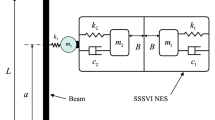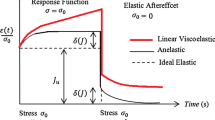Abstract
This paper focuses on the transient nonlinear dynamics and targeted energy transfer (TET) of a Bernoulli–Euler beam coupled to a continuous bistable nonlinear energy sink (NES). This NES comprises a cantilever beam with the partial constrained layer damping (PCLD) and an end mass controlled by a nonlinear magnetostatic interaction force. The theoretical model of the nonlinear system is built based on the Lagrange equations and assumed-modes expansion method. A new parameter system damping ratio is proposed to evaluate the TET efficiencies. Impact experiments are carried out to verify the theoretical model and mechanisms. The results show that the bistable NES can achieve high and strongly robust TET efficiencies under broad-range impacts. The shear modulus of the viscoelastic layer, the length of the PCLD and the end mass have significant influences on TET efficiencies. Analyses of the TET mechanisms in the bistable NES show the following: steady transition of the stable state is an important reason for maintaining high TET efficiencies; nonlinear beatings can occur in high-frequency, fundamental and long-period subharmonic branches; and resonance captures featuring fundamental and subharmonic also help achieve rapid energy dissipation.




















Similar content being viewed by others
References
Anubi, O.M., Crane III, C.D.: A new active variable stiffness suspension system using a nonlinear energy sink-based controller. Vehicle Syst. Dyn. 51(10), 1588–1602 (2013)
Kremer, D., Liu, K.F.: A nonlinear energy sink with an energy harvester: transient responses. J. Sound Vib. 333, 4859–4880 (2014)
Lee, Y.S., Vakakis, A.F., Bergman, L.A., McFarland, D.M., et al.: Passive non-linear targeted energy transfer and its applications to vibration absorption: a review. Proc. IMechE. Part K J. Multi-Body Dyn. 222(2), 77–134 (2007)
Gourdon, E., Lamarque, C.H., Pernot, S.: Contribution to efficiency of irreversible passive energy pumping with a strong nonlinear attachment. Nonlinear Dyn. 50, 793–808 (2007)
Gendelman, O.V.: Transition of energy to a nonlinear localized mode in a highly asymmetric system of two oscillators. Nonlinear Dyn. 25, 237–253 (2001)
Vakakis, A.F.: Inducing passive nonlinear energy sinks in vibrating systems. J. Vib. Acoust. 123, 324–332 (2001)
Vakakis, A.F., Gendelman, O.V.: Energy pumping in nonlinear mechanical oscillators: Part II-resonance capture. J. Appl. Mech. 68, 42–48 (2001)
Vakakis, A.F., Gendelman, O.V., Bergman, L.A., McFarland, D.M., Kerschen, G., Lee, Y.S.: Nonlinear Targeted Energy Transfer in Mechanical and Structural Systems. Springer, Dordrecht (2008)
Lee, Y.S., et al.: Enhancing the robustness of aeroelastic instability suppression using multi-degree-of-freedom nonlinear energy sinks. AIAA J. 46, 1371–1394 (2008)
Sapsis, T.P., et al.: Effective stiffening and damping enhancement of structures with strongly nonlinear local attachments. J. Vib. Acoust. 134, 011016 (2012)
Quinn, D.D., et al.: Equivalent modal damping, stiffening and energy exchanges in multi degree-of-freedom systems with strongly nonlinear attachments. Proc. Inst. Mech. Eng., Part K J. Multi-Body Dyn. 226(2), 122–146 (2012)
Gendelman, O.V., Sapsis, T., Vakakis, A.F., Bergman, L.A.: Enhanced passive targeted energy transfer in strongly nonlinear mechanical oscillators. J. Sound Vib. 330, 1–8 (2011)
Gendelman, O.V., Sigalov, G., Manevitch, L.I.: Dynamics of an eccentric rotational nonlinear energy sink. J. Appl. Mech. 79, 011012 (2012)
Sigalov, G., Gendelman, O.V., AL-Shudeifat, M.A., Manevitch, L.I., Vakakis, A.F., Bergman, L.A.: Resonance captures and targeted energy transfers in an inertially-coupled rotational nonlinear energy sink. Nonlinear Dyn. 69, 1693–1704 (2012)
Gendelman, O.V.: Analytic treatment of a system with a vibro-impact nonlinear energy sink. J. Sound Vib. 331, 4599–4608 (2012)
Karayannis, I., Vakakis, A.F., Georgiades, F.: Vibro-impact attachments as shock absorbers. Proc. IMechE. J. Mech. Eng. Sci. 222, 1899–1908 (2008)
Mohammad, A., Shudeifat, A.L.: Asymmetric magnet-based nonlinear energy sink. J. Comput. Nonlinear Dyn. 10(1), 014502 (2014)
Wierschem, N.E.: Targeted Energy Transfer Using Nonlinear Energy Sinks for the Attenuation of Transient Loads on Building Structures. Ph.D. thesis (2014)
Mohammad, A., Shudeifat, A.L.: Highly efficient nonlinear energy sink. Nonlinear Dyn. 76, 1905–1920 (2014)
Romeo, F., Manevitch, L.I., Bergman, L.A., Vakakis, A.: Transient and chaotic low-energy transfers in a system with bistable nonlinearity. Chaos 25, 053109 (2015)
Romeo, F., Sigalov, G., Bergman, L.A., Vakakis, A.F.: Dynamics of a linear oscillator coupled to a bistable light attachment: numerical study. J. Comput. Nonlinear Dyn. 10(1), 011007 (2015)
Manevitch, L.I., Sigalov, G., Romeo, F., Bergman, L.A., Vakakis, A.: Dynamics of a linear oscillator coupled to a bistable light attachment: analytical study. J. Appl. Mech. 81(4), 041011 (2014)
Manevitch, L.I.: The description of localized normal models in a chain of nonlinear coupled oscillators using complex variables. Nonlinear Dyn. 25, 95–109 (2001)
Farid, M., Gendelman, O.V.: Tuned pendulum as nonlinear energy sink for broad energy range. J. Vib. Control (2015). doi:10.1177/1077546315578561
Cottone, F., Vocca, H., Gammaitoni, L.: Nonlinear energy harvesting. Phys. Rev. Lett. 102, 080601 (2009)
Jia, Y., Seshia, A.A.: Directly and parametrically excited bi-stable vibration energy harvester for broadband operation. Transducers (2013). doi:10.1109/Transducers.2013.6626801
Harne, R.L., Wang, K.W.: A review of the recent research on vibration energy harvesting via bistable Systems. Smart Mater. Struct. 22, 023001 (2013)
Tang, L.H., Yang, Y.W., Soh, C.K.: Improving functiona-lity of vibration energy harvesters using magnets. J. Intell. Mater. Syst. Struct. (2012). doi:10.1177/1045389X12443016
Gao, Y.J., Leng, Y.G., Fan, S.B., Lai, Z.H.: Studies on vibration response and energy harvesting of elastic-supported bistable piezoelectric cantilever beams. Acta Phys. Sin. 63(9), 090501 (2014)
Vokoun, D., Beleggia, M., Heller, L., Sittner, P.: Magne-tostatic interactions and forces between cylindrical permanent magnets. J. Magn. Magn. Mater. 321, 3758–3763 (2009)
Vokoun, D., Beleggia, M., Heller, L.: Magnetic guns with cylindrical permanent magnets. J. Magn. Magn. Mater. 324, 1715–1719 (2012)
Avvari, P.V., Tang, L.H., Yang, Y.W., Soh, C.K.: Enhan-cement of piezoelectric energy harvesting with multi-stable nonlinear vibrations. Proc. of SPIE (2013). doi:10.1117/12.2009560
Jones, D.I.G., et al.: Handbook of Viscoelastic Vibration Damping. Wiley, Chichester (2001)
Edward, J., Kerwin, M.: Damping of flexural waves by a constrained viscoelastic layer. J. Acoust. Soc. Am. 31(7), 952–962 (1959)
Plunkett, R., Lee, C.T.: Length optimization for constrained viscoelastic layer damping. J. Acoust. Soc. Am. 48, 150–161 (1970)
Hou, S.W., Jiao, Y.H., Wang, X., Chen, Z.B., Fan, Y.B.: Optimization of plate with partial constrained layer damping treatment for vibration and noise reduction. Appl. Mech. Mater. 138–139, 20–26 (2012)
Ling, Z., Ronglu, X., Yi, W., El-Sabbagh, A.: Topology optimization of constrained layer damping on plates using method of moving asymptote (MMA) approach. Shock Vib. 18(1), 221–244 (2011)
Kim, S.Y.: Topology Design Optimization for Vibration Reduction: Reducible Design Variable Method. Queen’s University, Kingston (2011)
Mead, D.J., Ae, D.C.: The effect of a damping compound on jet-efflux excited vibrations: an article in two parts presenting theory and results of experimental investigation. Part I. The structural damping due to the compound. Aircr. Eng. Aerosp. Technol. 32, 64–72 (1960)
Mead, D.J.: A comparison of some equations for the flexural vibration of damped sandwich beams. J. Sound Vib. 83, 363–377 (1982)
Shi, H.M., Huang, Q.B.: Vibration Systems: Analyzing, Modeling, Testing, Controlling. 3rd edn. Huazhong University of science and Technology Press (2014), in Chinese
Acknowledgements
This research was funded by the National Nature Science Foundation of China (Project Nos. 51405502 and 51275519). The authors would also like to acknowledge Associate Professor Yong Xiao and Doctor Xin Wang for their technical assistance.
Author information
Authors and Affiliations
Corresponding author
Electronic supplementary material
Below is the link to the electronic supplementary material.
Appendix
Appendix
The kinetic energies of different parts can be expressed as
where \(J_t\) is the end mass’s moment of inertia relative to the axis oz in Fig. 2b, \(J_t ={m_t R_1^2 }/4+{m_t d_1^2 }/{12}\).
The elements in the generalized mass matrix and generalized complex stiffness matrix are listed below.
Rights and permissions
About this article
Cite this article
Fang, X., Wen, J., Yin, J. et al. Highly efficient continuous bistable nonlinear energy sink composed of a cantilever beam with partial constrained layer damping. Nonlinear Dyn 87, 2677–2695 (2017). https://doi.org/10.1007/s11071-016-3220-4
Received:
Accepted:
Published:
Issue Date:
DOI: https://doi.org/10.1007/s11071-016-3220-4




